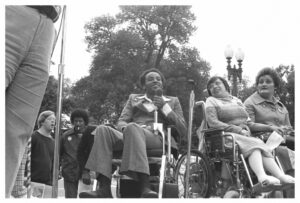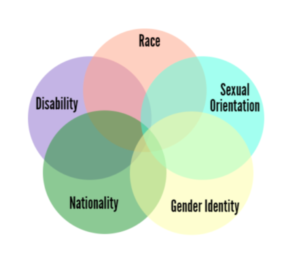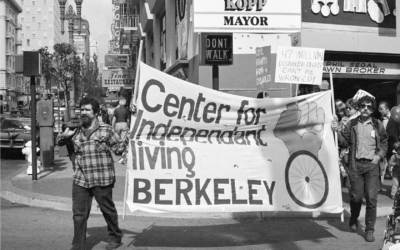In 2021, CPWD created a staff-inspired IDEA Committee (Inclusion, Diversity, and Equity in Action). The mission of CPWD’s IDEA Committee is to foster a culture that promotes diversity, equity, and inclusion while actively challenging and dismantling systemic racism and oppression. Read the IDEA Committee’s full public statement.
The IDEA Committee was catalyzed into formation as the world watched the horrific death of George Floyd, and racial violence and systemic oppression were once again illuminated from the shadows of American society.
Considering last week we celebrated Martin Luther King, Jr. Day, it’s important to note that his efforts towards racial equality happened in the early ‘60s…about 60 years ago! More than half a century later, we still witness systemic oppression and violence toward many marginalized populations. We also noted in our last blog how the Independent Living Movement followed the Civil Rights Movement and fought hard for rights and equality for people with disabilities 50 to 60 years ago.
It was Dr. King who in 1966 said, “Of all forms of discrimination and inequalities, injustice in health is the most shocking and inhumane.”

Brad Lomax, the founder of the D.C. chapter of the Black Panther Party, center, next to the activist Judy Heumann at a rally in 1977 at Lafayette Square in Washington. Credit…HolLynn D’Lil
Section 504 and the Black Panther Party
In April of 1977 began a sit-in in San Francisco which was held to protest against the delay in passing Section 504 of the Rehabilitation Act which would prevent employment discrimination based on disability. This sit-in protest to this day is the longest peaceful occupation protest in U.S. History. The sit-in protest was largely supported by members of the Black Panther Party who joined in the protest, able-bodied and people with disabilities disabled alike, providing meals and officially stating to the press: “The issue here is human rights – rights of meaningful employment, of education, of basic human survival – of an oppressed minority, the disabled and handicapped.”
In this way, civil rights based on race, and disability rights, have intersected for more than half a century. Today, the heavy veil of oppression is still being lifted, exposing further marginalization and discrimination of even people in areas such as gender, sexual orientation, and nationality. What’s being uncovered is that these groups overlap, and many people find themselves in more than one category. This is called intersectionality.

Examples of Intersectionality
Intersectionality
Two key components of intersectionality are 1) the common striving for equality, equality, and the alleviation of marginalization and discrimination; and 2) preventing discrimination within discrimination by finding common ground together.
CPWD’s IDEA Committee is committed to education and information, but also to action. For example, the IDEA Committee organized internal organizational training on intersectionality, racism, and gender discrimination, and has partnered with other organizations, such as Out Boulder County on Beyond Binary education and training.
“We also conducted a training on implicit bias,” said Marni Tharler, IDEA Committee member. “The trainer explained how everyone has biases. Not everything is as obvious as you think. For example, one person could be raised with a certain work ethic, while another person has a different approach. There can be a bias there, and suddenly there is judgment. We had conversations about how we may not always say the right thing or know the right answer because of that bias. We discovered that even the most conscientious, self-aware people can have implicit biases they weren’t aware of.”
Further, CPWD has a board-sanctioned, fully-inclusive non-discrimination policy for employment, added Juneteenth and Veteran’s Day as official holidays, and no longer celebrates Columbus Day. The homepage of the website displays a banner in fidelity with Black Lives Matter.
“This isn’t something that happens universally with all organizations,” remarked Tharler. “It’s a big deal to create an organizational culture of values, and we are proud of that.”
Taking Action
The IDEA Committee recognizes that for individuals – staff, consumers, and friends – to carry such values, the organization must first champion, live, and embody these values.
“It’s easy to read articles, blog posts, and take trainings,” explained Craig Towler, a member of the IDEA Committee. “But it is more challenging to take the next step, and we want to be thoughtful about what we are doing. We want to put things out to our community and not ask them to do things we haven’t done ourselves. We aren’t just people with disabilities helping people with disabilities, we are different races, nationalities, and sexual orientations, and are unique. We are more than that, so we need to understand how we intersect with all these parts of identity and how they compound each other. You won’t understand a person’s needs until you understand the multiple factors affecting that person.”
As the IDEA Committee further evolves, we want to continue to partner with consumers or community partners who want to collaborate, offer diverse perspectives, and work together to address intersectionality.
If you would like to learn more about the IDEA Committee, sign up for email updates below!
To get involved or collaborate, please contact Marni Tharler at [email protected]





